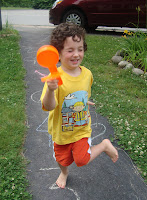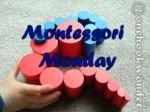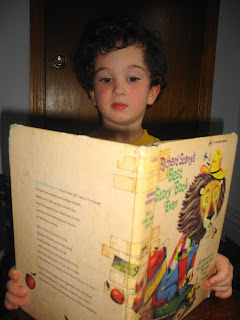Finally, here is the Outdoor Space thoughts that I promised in
my last Creative Curriculum ® for the Home post before computer woes and other obstacles slowed my course for a couple weeks.
Why focus on the Outdoor Space right now, when our indoor spaces are all still demanding so much attention? Well, because good weather is upon us and we find ourselves outside enjoying it more and more often. I cannot exactly keep the kids (or Mike and me for that matter) inside all the time focused solely on my Order in the Home(school) goal. But, I can find a nexus between that goal and our desire to enjoy the great outdoors! The
Creative Curriculum
® (CC) makes this easy by offering concise guidelines and helpful tips for maximizing the potential of one’s Outdoor Environment. This delights me! For both theory and practice often draw us for Jammies School.
On the theory side, almost all of the philosophies and methods that I am attracted to seem to emphasize outdoor learning, exploration and play. Charlotte Mason, perhaps, places the greatest prominence on the outdoors, suggesting that children spend hours outside each day regardless of the weather. Montessori schools often have beautiful outdoor “classrooms” or gardens. Reggio tends to connect art to nature. Even our faith studies lead our family outdoors – exploring and being grateful for all God’s amazing creations. Thus, it is no big surprise that I was pleased when I discovered that the
Creative Curriculum
® (CC) places importance on outdoor learning, too. Theoretically, it works!
Plus, in practice, outdoor time work for us, too. Reading on blankets. exploring science through bubbles. Drawing with chalk on the sidewalk, drive and an outdoor easel. Doing coloring and crafts on the back deck.. Counting pinecones, flowers, clouds. Playing "Can You Find Something (color)?" Singing about the great things we see that the Lord has made. You name it, we enjoy doing it outside. Indeed, our Outdoor Environment is a natural place for us to focus on our Core Four, Plus. (Faith, Reading, Writing, Arithmetic and Extras)
So, what does the CC have to say about Outdoor Areas and how can it help us improve our own?
The chapter in the CC that deals with the Outdoors discusses “How Outdoor Play Promotes Development”, “What Children Learn Outdoors”, “The Teacher’s Role” and “
A Letter to Families about Outdoor Play”. It also details “Creating and Using the Outdoor Environment”, which is what I have focused in on as I continue Order in the Home(school) journey, using the CC as a tool.
The first step the CC suggests in creating and using the Outdoor Environment is to assess one's outdoor space in order to ensure that there is enough room to accommodate all the children that will be using it at the same time, e.g. 80-100 square feet per child. This may be out of reach for some family housing arrangements, but – never fear – that’s what parks and playgrounds are for.
Regardless of if you are looking at only your own yard, or at your yard, plus some local open spaces, the CC offers a list of parameters to that can be helpful when thinking about an ideal environment. These are that your Outdoor Space should include:
- an unobstructed view of the children at all times (when you are not hanging laundry, doing outdoor chores, grabbing the phone, etc.!)
- easy access to and from the indoor space and a bathroom (or a tolerance for emergency potty breaks in out-of-the-way parts of the yard for potty training kiddos like mine)
- a drinking fountain and water spigot for attaching a hose (or simply a full water bottle at hand, along with some sort of hose, pond, stream or pool as a water play source)
- age-appropriate equipment for climbing, swinging and building (or some semblance thereof, depending on the size of your yard. For example, our outdoor space precludes a traditional swing set, but we do have climbing and building things and may eventually get a swing to hang from our deck or to tie from a sturdy tree branch. Until such time, we use the neighbor’s swing set and nearby playgrounds, extending our outdoor area significantly.)
- a storage shed (or some sort of storage plan using re-purposed materials, crates, plastic bins, a garage...)
- soft materials, such as sawdust, sand or bark under swings, slides and climbers (if you have the space for such things and the funds for the ground cover. If not, local playgorounds are usually up to safety codes and, as long as you use your common sense and promise not to sue yourself, your own home spaces should work fine, too, however you fir those swings and climbers into it.)
- sunny as well as shady areas (Natural ones are best – think trees, sunflower houses, etc. for shade, but rope and blankets can be fun, too!)
- a paved or hard-surfaced area for riding, skating, chalk drawings and games (which for home learners not blessed with much sidewalk or driveway sopace, but who live on quiet streets, may just be the street itself, and for those on busier streets, might be a nearby tennis court or parking lot)
- a covered area for use during wet weather (or a sense of fun and good protective clothing – puddle jumping and getting wet are part of growing up!)
- places to be alone with one or two others (boxes, tents, tires, a porch swing, blankets. etc.)
- open, grassy spaces for walking, tumbling, running, kicking, throwing and catching balls (which may just be found at a nearby park if not in your own yard)
- an area for digging (sandbox, rough ground, even just a box of dirt!)
Now, of course, this list was written with preschool centers in mind, but it can easily be adapted to home use, as I noted in my parenthetical comments. And, once you’ve assessed where in your own yard or community you might find each of the CC’s suggested components for an Outdoor Environment, you might do well to go on, as we have done, to carving out little parts of it for the different kinds of experiences and challenges that the CC suggests. These include:
- playing in sand and water
- riding on, and pushing and pulling, wheeled toys
- using indoor materials that can be brought outdoors
- playing games, building constructions and enjoying pretend play
- planting a garden
- caring for living things
Now, with this list (and the paragraphs of details and suggestions that follow it in the CC book) in mind, it is easy to self-assess and create order and appeal in one’s Outdoor Environment. To help you along, let me share our thought process for doing so:
Do we have a sand and water play area, located near a water supply if possible, so children can explore the properties of both wet and dry sand, as well as the properties of water? And is it equipped with a variety of tools for such exploration?
 Yes! Currently we have two freecyled covered green sandboxes. One we use for sand (and mud!) and the other for water (and shaving cream, and bubbles and...) These migrate throughout our small back yard depending on where the kids want to play – in sun or shade. We also have a variety of props we've collected for the kids to use when playing in these – buckets, old bowls and pails with handles, shovels, spoons and scoops; funnels and sifters; old pots, pans and molds; plastic pitchers and jugs; old trucks, busses and cars; plastic people and animals; natural objects, such as pinecones, shells, sticks and stones; etc. the kids don;t tire of our little sand and water spaces yet anyway. (Admittedly, we are still trying to repurpose something for better storage of these. Ideas are welcome!)
Yes! Currently we have two freecyled covered green sandboxes. One we use for sand (and mud!) and the other for water (and shaving cream, and bubbles and...) These migrate throughout our small back yard depending on where the kids want to play – in sun or shade. We also have a variety of props we've collected for the kids to use when playing in these – buckets, old bowls and pails with handles, shovels, spoons and scoops; funnels and sifters; old pots, pans and molds; plastic pitchers and jugs; old trucks, busses and cars; plastic people and animals; natural objects, such as pinecones, shells, sticks and stones; etc. the kids don;t tire of our little sand and water spaces yet anyway. (Admittedly, we are still trying to repurpose something for better storage of these. Ideas are welcome!)
Ultimately, we hope to build a large, more natural sand and dirt area under out deck using logs for borders, lots of sand in one section and a mini-mountain of dirt in another section, but, for now, our small plastic sandboxes dot he trick just fine! Also, even though we would love to get a small wheelbarrow to add to our props and, sometimes find ourselves scoping out,wished-for items in stores and catalogs, we realize that popsicle sticks, plastic spoons and some recycled plastic containers with holes punched in the lids or bottoms, work just fine as sand and water props, and, in all honesty, the rest is just blessed surplus. When it all comes down to it, even a box full of sand a d a small dish tub full of water, with such recycled materials would work.
A good point of advice that the CC reminds us of though, regardless of what materials are used, is to cover the sand area with a hinged lid, plastic sheet or similar when not in use. Cats and other animals love to use sandboxes as litter boxes and health problems can be avoided with this simple precautionary measure.
Do we have an area where the kids can pedal, push and pull wheel toys to build large muscle strength while promoting balance and coordination?
 Indeed! We have a variety of handed-down trikes, scooters and push-with-your legs ride-ons, plus a too-big Green Machine, a kids’ plastic shopping cart and a doll stroller at the moment, And we have an eye out for wagons, wheelbarrows and bikes... We use these on the sidewalk and the cul de sac we live on, and, when we feel it is safe, on our very steep driveway. With safety in mind, of course, we have helmets available. Along with these wheelie toys, we sometimes use chalk or orange cones to add to our wheelie toy play and, with CC suggestions in mind, we are planning to gather up materials for making signs and creating road markers and directional arrows. We would also like to start extending our wheelie toy play more through the use of prop boxes or play crates that can transform our collection into ambulances, fire trucks, mail trucks, gas station equipments, a car wash, etc. (Okay, so the hose and a few dish pans did well the other day for a car wash!)
Indeed! We have a variety of handed-down trikes, scooters and push-with-your legs ride-ons, plus a too-big Green Machine, a kids’ plastic shopping cart and a doll stroller at the moment, And we have an eye out for wagons, wheelbarrows and bikes... We use these on the sidewalk and the cul de sac we live on, and, when we feel it is safe, on our very steep driveway. With safety in mind, of course, we have helmets available. Along with these wheelie toys, we sometimes use chalk or orange cones to add to our wheelie toy play and, with CC suggestions in mind, we are planning to gather up materials for making signs and creating road markers and directional arrows. We would also like to start extending our wheelie toy play more through the use of prop boxes or play crates that can transform our collection into ambulances, fire trucks, mail trucks, gas station equipments, a car wash, etc. (Okay, so the hose and a few dish pans did well the other day for a car wash!)
Do we have a garden located away from more active outdoor areas?
 Yes, we have a flower bed next to our driveway and a small “lasagna garden” planted with tomato pepper seedlings and some herb seeds we hope will actually grow. As our yard is relatively small, and somewhat shady – and as none of us has yet to develop a true green thumb – we also hope to use some small, movable container gardens in the future. (The CC even suggests simply placing a container garden on a two-wheeled cart or wagon so it can moved around to control the amount of sun it gets and to clear space for games – great idea!) To help us with our gardening efforts, we have several child-sized shovels, rakes and hoes, watering buckets and a hose and, of course, seeds and plants. Over time, we hope to get better at planting relatively quick-growing, child-friendly, useful and appealing gardens to help the kids enjoy and learn, especially the inevitable lessons of patience and perseverance that gardening requires.
Yes, we have a flower bed next to our driveway and a small “lasagna garden” planted with tomato pepper seedlings and some herb seeds we hope will actually grow. As our yard is relatively small, and somewhat shady – and as none of us has yet to develop a true green thumb – we also hope to use some small, movable container gardens in the future. (The CC even suggests simply placing a container garden on a two-wheeled cart or wagon so it can moved around to control the amount of sun it gets and to clear space for games – great idea!) To help us with our gardening efforts, we have several child-sized shovels, rakes and hoes, watering buckets and a hose and, of course, seeds and plants. Over time, we hope to get better at planting relatively quick-growing, child-friendly, useful and appealing gardens to help the kids enjoy and learn, especially the inevitable lessons of patience and perseverance that gardening requires.
Do we have areas where children can practice caring for living things?
 Yes, not only do our gardens help us teach the kids about plants, but we try to observe and learn about all creatures, great and small, that visit our yard. We regularly make and hang bird feeders and have a bird bath, and we have making birdhouses on our to-do list. We also leave our spent blooms up a for a while to attract birds and bugs to come feed. A bunny visits us regularly. Cats come by. Sometimes other animals do, too. And, we compost – a great boon for worm study!
Yes, not only do our gardens help us teach the kids about plants, but we try to observe and learn about all creatures, great and small, that visit our yard. We regularly make and hang bird feeders and have a bird bath, and we have making birdhouses on our to-do list. We also leave our spent blooms up a for a while to attract birds and bugs to come feed. A bunny visits us regularly. Cats come by. Sometimes other animals do, too. And, we compost – a great boon for worm study!
Do we have open spaces for games, building and pretend play, plus equipment to facilitate such play?
 Indeed, our front yard is mostly open and grassy – a great place to run about and have fun, as well as to catch bubbles, climb on a small plastic climber, set up tents, play chase, etc. And, our back yard has areas where the kids can enjoy construction (using an old screen, blankets, ropes, clothespins, etc. regularly and hammers, nails and whatnot, occasionally, with closer supervision) and pretend play (where an old plastic shelving unit and stove burner covers from our old stove have made a rather nice outdoor play kitchen area for the kids and some recalled door swings make for a dollie play area). Plus, we are on the look out for “loose parts” and sundry recycled and re-purposed materials to feed the kids’ construction-imaginations. Planks of wood, plastic crates, carpet samples and scraps, cable spools, old tires, appliance store boxes, plastic pipes and elbows. One person’s junk can be our children’s building treasures. Once our new baby comes and we get our house in order (or at least the former!), we hope to start collecting some of these materials (even if we are in the midst of trying to purge many things!)
Indeed, our front yard is mostly open and grassy – a great place to run about and have fun, as well as to catch bubbles, climb on a small plastic climber, set up tents, play chase, etc. And, our back yard has areas where the kids can enjoy construction (using an old screen, blankets, ropes, clothespins, etc. regularly and hammers, nails and whatnot, occasionally, with closer supervision) and pretend play (where an old plastic shelving unit and stove burner covers from our old stove have made a rather nice outdoor play kitchen area for the kids and some recalled door swings make for a dollie play area). Plus, we are on the look out for “loose parts” and sundry recycled and re-purposed materials to feed the kids’ construction-imaginations. Planks of wood, plastic crates, carpet samples and scraps, cable spools, old tires, appliance store boxes, plastic pipes and elbows. One person’s junk can be our children’s building treasures. Once our new baby comes and we get our house in order (or at least the former!), we hope to start collecting some of these materials (even if we are in the midst of trying to purge many things!)
Do we have indoor materials that can be brought outdoors on nice days both to facilitate learning and to provide a new environment for "old" experiences?
 Yes, we often use our back deck as an outdoor extension of our indoor learning spaces, and I am working on creating organized grab-and-go type bins or bags to keep by each entrance of our home according to the outdoor activities we pursue by it. We also sometimes take Movement and Music props out to the deck or front yard to sing, dance parade and play. We do art activities on the deck, in the sensory sandbox, on the driveway and sidewalk, etc.. (And, we have plans to do even more “Messy Art” outside as the weather continues to be so nice!). Dramatic play props, most often, of late, in the form of dolls and accessories – the kids’ “kids”, often find their way outside for pretend play with the kids building houses and forts for them, giving them rides, taking them for walks, etc. And, books are not only enjoyed aplenty during reading sessions on the porch rocker, the deck rocker and on blankets on the lawn, but are also referred to during nature observation and study. (The One Small Square
Yes, we often use our back deck as an outdoor extension of our indoor learning spaces, and I am working on creating organized grab-and-go type bins or bags to keep by each entrance of our home according to the outdoor activities we pursue by it. We also sometimes take Movement and Music props out to the deck or front yard to sing, dance parade and play. We do art activities on the deck, in the sensory sandbox, on the driveway and sidewalk, etc.. (And, we have plans to do even more “Messy Art” outside as the weather continues to be so nice!). Dramatic play props, most often, of late, in the form of dolls and accessories – the kids’ “kids”, often find their way outside for pretend play with the kids building houses and forts for them, giving them rides, taking them for walks, etc. And, books are not only enjoyed aplenty during reading sessions on the porch rocker, the deck rocker and on blankets on the lawn, but are also referred to during nature observation and study. (The One Small Square series is one we love!) And, if I ever get my desired Montessori and workboxing systems up and running, many of our trays and drawers from these will be taken outdoors, too, no doubt. Thus, it seems we are doing just fine with bringing inside materials out. The only thing we need a little help with is keeping them organized and finding their way back “home”. To this end, we are thinking about creating “play crates” as suggested in the CC for camping, laundry, painting, digging, gardening, woodworking, etc. Doing so, we think, will help us optimally store and rotate materials, we hope.
series is one we love!) And, if I ever get my desired Montessori and workboxing systems up and running, many of our trays and drawers from these will be taken outdoors, too, no doubt. Thus, it seems we are doing just fine with bringing inside materials out. The only thing we need a little help with is keeping them organized and finding their way back “home”. To this end, we are thinking about creating “play crates” as suggested in the CC for camping, laundry, painting, digging, gardening, woodworking, etc. Doing so, we think, will help us optimally store and rotate materials, we hope.
And, so that’s our Outdoor Area thoughts and assessment. Whew, it was long! But, what can you expect when discussing something as huge as the great outdoors? Besides, I am pleased that by taking the time to reflect on our outdoor space, I have not only considered, tidied up and re-envisioned some of it, recognizing we are in great shape even if there are still some "wants", but that we also continue to work toward the main goal – creating better order in our home(school), even as we simply enjoy being outdoors.
That said, I am now ready to escape the recent heat and to tackle thinking about something a little smaller. So,
within a week, I hope to post about the next step on our CC for the Home journey - notes on Displaying and Labeling materials. Please stay tuned…
In This Series:
One final note, as I have mentioned before, if you would like to join me on this CC journey, please leave comments. When thinking about your own outdoor area, you may want to take a peek at the Outdoors pdf at Teaching Strategies, which details what children learn outdoors by subject and how we might interact with children as they learn and play outdoors. Also, of course, if you want to journey with me, you can grab a copy of the CC book yourself to review and let me know what you're getting from it. Or, use my summaries and posts as a starting point for thought. Tell me how you're moving from theory to practice in your own home. Cheer me on (or give me constructive criticism) about how I am doing. Or, simply jot down whatever comes to mind. Deep conversation or silly banter -- my adventures have always been all the better for sharing both along the way. Thanks!






















